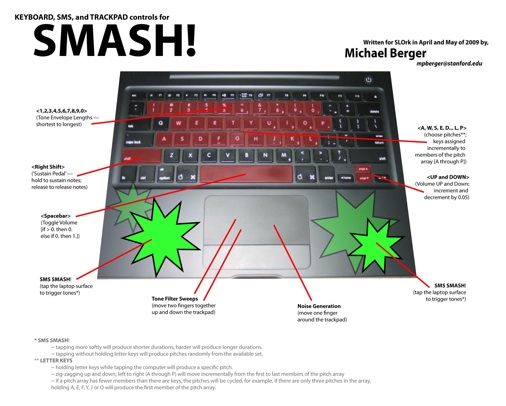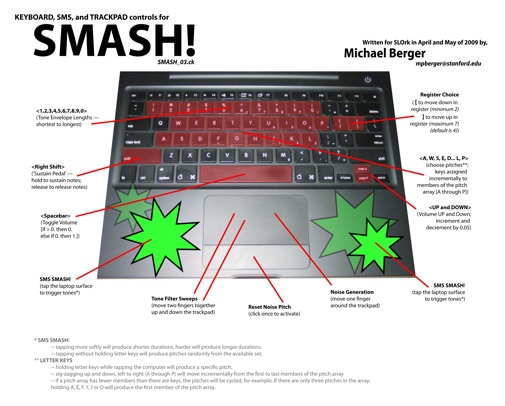128-spring-2009/group17: Difference between revisions
| Line 31: | Line 31: | ||
====Drum Circle==== | ====Drum Circle==== | ||
[[SLOrk/Instruments/DrumCircle]] | |||
[ | |||
====SMASH!™ (SMASH_01.ck)==== | ====SMASH!™ (SMASH_01.ck)==== | ||
Revision as of 17:43, 19 May 2009
Morning SMASH!
"Morning SMASH!" (2009) by Nick Bryan, Visda Goudarzi, Charles Luskin, and Michael Berger
Program Description: "Morning SMASH!" is a structured improvisation featuring two software musical interfaces written by Nick Bryan and Michael Berger respectively. The piece juxtaposes smooth drone-like melodic strands with abrupt and rhythmic percussive outbursts, and explores the space between these two disparate elements. Both software interfaces utilize transients on the computers' "Sudden Motion Sensors" in order to trigger and control the sounds.
FILES
See SLORK SVN
ORCHESTRATION
(2) SMASH_01.ck (S01) -one high pitch -one lower pitch or bass
(2) Drum Circle (DC) -one with tom drum sounds -one with Tabla sounds
SCORE/INSTRUCTIONS
The piece can be divided into three and one half parts. The beginning starts out with the high S01 voice exploring timbre space for roughly 1-1.5 minutes (section I). Near the end of section I, the scratching sound of S01 begins and signals the beginning section II. Section II introduces both DC voices and the lower S01. Over the course of 2-3 minutes the drums gradually increase with relatively constant rhythm. There's no specific section ending, but by intuition, the S01 pitched material drops out and fades to scratchy sounds that accompany the drumming that becomes the overall focus for section III. Section III is relatively short (ca. 1min), and features only percussive sounds from all players. At the end of section III, one of the drummers (DC) signals the end is near and everyone enters the coda at the same time (cued by the first S01 player). The coda is made up of 1-4 simultaneous rhythmic strikes in all instruments; the section should be no more than 30 seconds long, and ends with the gradual fading of sound from all instruments.
AUDIO+VIDEO REQUIREMENTS/FLOOR PLAN
Four SLORK stations arranged in a square pattern with similar instrument types at opposite sides faces one another. Ideally, the four stations would be positioned in the center of the audience.
INSTRUMENT INSTRUCTIONS
Drum Circle
SMASH!™ (SMASH_01.ck)
- Run miniAudicle, open file: "SMASH_01.ck"
- [You will need miniAudicle 0.1.3.9 to run this properly]
- BEFORE ADDING TO SHREDULER:
- select mode (line 6 of code):
- 0 for normal mode (middle-range pitches)
- 1 for bass mode (low-range pitches)
- adjust SMASH™ attack threshold (line 20)
- 50 for MacBook Pro 17"
- 80 for Black SLOrk Macbook
- (adjust to feel, see below)
- select mode (line 6 of code):
- Add Shred!
- Lock miniAudicle window with 'cmd + E'
- if the Virtual Machine hangs, click "Continue" not "Abort"
- PLAYING INSTRUCTIONS
- Playing SMASH!™ "Tones":
- tap anywhere on the MacBook or on the floor or the table supporting the computer, sounds will be triggered by your tapping (pitches will be randomly chosen by the computer from the array of intervals given in lines 35 through 37 of the code)
- get a feel for the force you need to trigger sounds, softer taps will result in shorter tones, harder with longer
- if the triggering is not responsive, unlock the window, remove the shred, and adjust the threshold value on line 20 of the code to the appropriate level (higher values result in less responsiveness)
- try scrolling two fingers up and down on the trackpad after you trigger a note, this action will move the resonant frequency of a low pass filter on the sound and thereby give you control over the timbre
- holding a letter key while tapping will force the triggered tone to be a certain pitch
- the letters are ordered from lowest to highest: A, W, S, E, D, R, F, T, G, Y, H, U, J, I, K, O, L, and P. (zig-zag order)
- each letter is associated with a position in the pitch array; i.e. A will be pitch #0, W pitch #1, and so on.
- if the array is shorter than the number of keys (A-P) then the pitch-assignments will cycle; i.e. if there are only 3 notes in the array, A, E, F, Y, J, and O will isolate pitch #0, W, D, T, H, I, and L will isolate pitch #1, and so on.
- [you can trigger a note and isolate its pitch by roughly typing the letter key of your choosing]
- holding the RIGHT SHIFT button will sustain any tones triggered until the button is released.
- the SPACE BAR will mute the audio if the volume is not already muted, and restore it to maximum (1.0) again if pressed a second time
- the UP and DOWN arrows increment and decrement the overall volume level by 5% each.
- the number keys: 1, 2, 3, 4, 5, 6, 7, 8, 9, and 0 will choose between different envelope lengths: 1 being the shortest, and 0 the longest (default is 4).
- Playing SMASH!™ "Scratches":
- move one finger around on the trackpad, you will hear a "scratching" sound.
- the sound increases in frequency when the speed of your finger motion increases
- the sound will stop if your finger stops
- a flick of the finger, or an abrupt release will cause the sound to continue after you stop touching the pad, touching the pad again and releasing more carefully will then stop the sound
- motion upwards will lower the "pitch" of the noise, motion downwards will increase it
- clicking the trackpad button will reset the pitch of the noise
- move one finger around on the trackpad, you will hear a "scratching" sound.
- Please see the photo below for a summary of these controls.
 (LARGER VERSION HERE)
(LARGER VERSION HERE)
Evening SMASH!
"Evening SMASH!" (2009) by Nick Bryan, Visda Goudarzi, Charles Luskin, and Michael Berger
Program Description: Complementing last week's performance of Morning SMASH!, Evening SMASH! is a structured improvisation featuring two software musical interfaces written by Nick Bryan and Michael Berger respectively. The piece opens with a violent upheaval of glitch-inspired and woodblock-like percussion. These sounds are soon accompanied by drones that evolve into an bass ostinato. High pitches punctuate and bring the texture to a groove which then drowsily fades away as the piece concludes. Both software interfaces utilize transients on the computers' "Sudden Motion Sensors" in order to trigger and control the sounds.
FILES
See SLORK SVN
ORCHESTRATION
(2) SMASH_03.ck (S03) -one high pitch (register 6, envelope 1) -one lower pitch (register 2-4, envelope 5-7 + sustain)
(2) Drum Circle (DC) -one with low tone sounds -one with tom tom / "woodblock" sounds
SCORE/INSTRUCTIONS
The piece can be divided into four sections. The first section begins with upwards-sweeping noise material from both S03 players. The players gradually crescendo in from niente and randomly reset the pitch of their sweeps (offset from each other). When an agreed-upon height of the crescendo is reached the players abruptly break from their sweeping material and enter into harsh "glitch-like" outbursts. At this point they are joined by the DC player with drum samples. A counterpoint of outbursts is improvised. Gradually the S03 player in the lower register begins long tapered pitch- and/or chordal-tones to signal the slow entrance of the last player (DC on tones). Ideally this player will enter so as to fade subtly into the tones produced by the second S03 player. This entrance signals the transition into the second section of the piece. The opening section should take between 1.5 and 3 minutes.
In the second section all of the players work together in an arhythmic but at the same time rhythmically charged space, to coalesce the materials into a cohesive groove. The high S03 player is now free to being adding sparse blips and bloops on his/her insterment (envelope 1, register 6-7). Both S03 players continue to play rhythmic outbursts with their glitch noises, but gradually reduce them for the groove section. This section should take 1-1.5 minutes, and is ended when all players arrive in the pieces 5/4 groove.
The groove may be expanded upon or reduced, but is largely maintained by the tone-playing DC player. The rhythm of the groove is as follows: in 5/4: quarter, eighth, quarter, eighth, quarter, quarter. This third section is largely a rhythmically charged jam, featuring increases in dynamics and material-densities in all four players. Once the "jam" reaches its natural height the percussive DC player signals the others with special attention paid to the lower S03 player who will then cue the sudden exit of both he/she and the percussive DC, and thereby not only leaving the high-register S03 and toned DC suddenly exposed, but also bringing the third section to a close.
The final section of the piece features a gradual slow-down in the two remaining players. This slow-down is facilitated largely by the S03 player whose dense and active rhythms become slower, sparser, longer, lower, and quieter as time passes. The other S03 player may during this section play slow quiet long-tones in the background as he/she pleases, but should by no means become present in the remaining texture. The tone DC player maintains his/her rhythm until the last S03 player has faded and then slowly decrescendos and finds a tonal downbeat on which to end.
AUDIO+VIDEO REQUIREMENTS/FLOOR PLAN
Four SLORK stations arranged in a square pattern with similar instrument types at opposite sides faces one another. Ideally, the four stations would be positioned in the center of the audience.
INSTRUMENT INSTRUCTIONS
Drum Circle
- [to be filled in by Nick]
SMASH!™ (SMASH_03.ck)
- Run miniAudicle, open file: "SMASH_03.ck"
- [You will need miniAudicle 0.1.3.9 to run this properly]
- BEFORE ADDING TO SHREDULER:
- select mode 0 (line 6 of code):
- adjust SMASH™ attack threshold (line 20) if needed
- 50 for MacBook Pro 17"
- 80 for Black SLOrk Macbook
- (adjust to feel, see explanation in Morning SMASH! above)
- Add Shred!
- Lock miniAudicle window with 'cmd + E'
- if the Virtual Machine hangs, click "Continue" not "Abort"
- PLAYING INSTRUCTIONS
- Playing SMASH!™ "Tones":
- (see explanation above)
- NEW!!!
- select pitch register with "[" and "]" (down and up respectively)
- chose registers starting on C2 to C7
- NEW!!!
- Playing SMASH!™ "Scratches":
- (see explanation above)
- a flick of the finger, or an abrupt release (NEW USE!!!) will cause the sound to continue after you stop touching the pad, touching the pad again and releasing more carefully will then stop the sound
- motion upwards will lower the "pitch" of the noise, motion downwards will increase it
- clicking the trackpad button will reset the pitch of the noise
- NEW PART!!!: if the pitch of the noise goes too high the filter will begin to fold over onto itself, this causes the glitch-noises that are utilized in Evening SMASH!™.
- (see explanation above)
- Please see the NEW!!! photo below for a summary of these controls.
 (LARGER VERSION HERE)
(LARGER VERSION HERE)